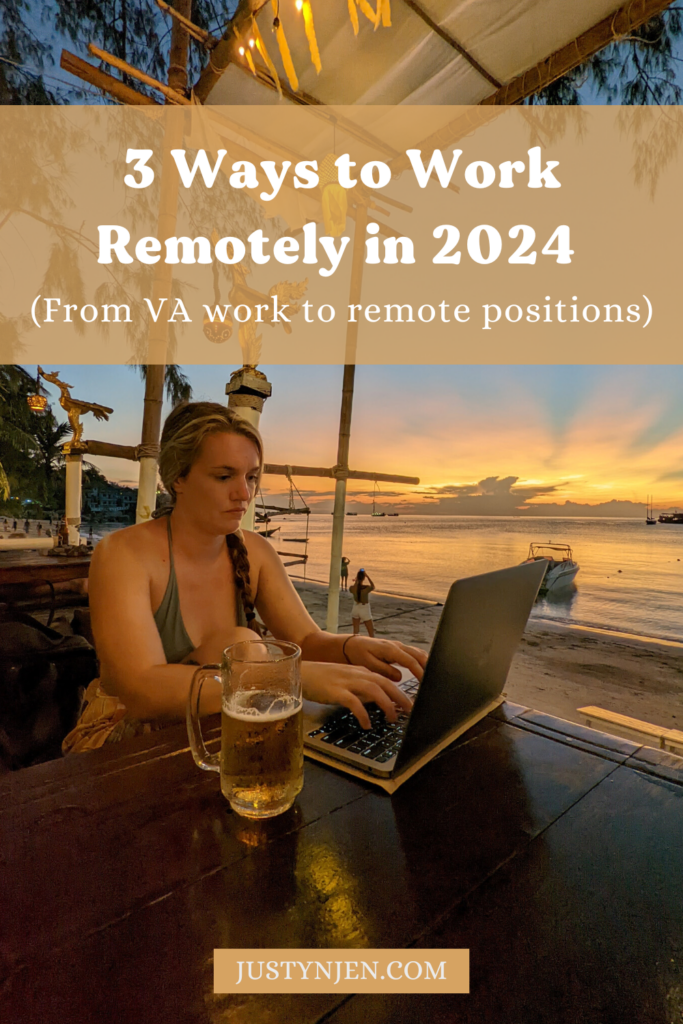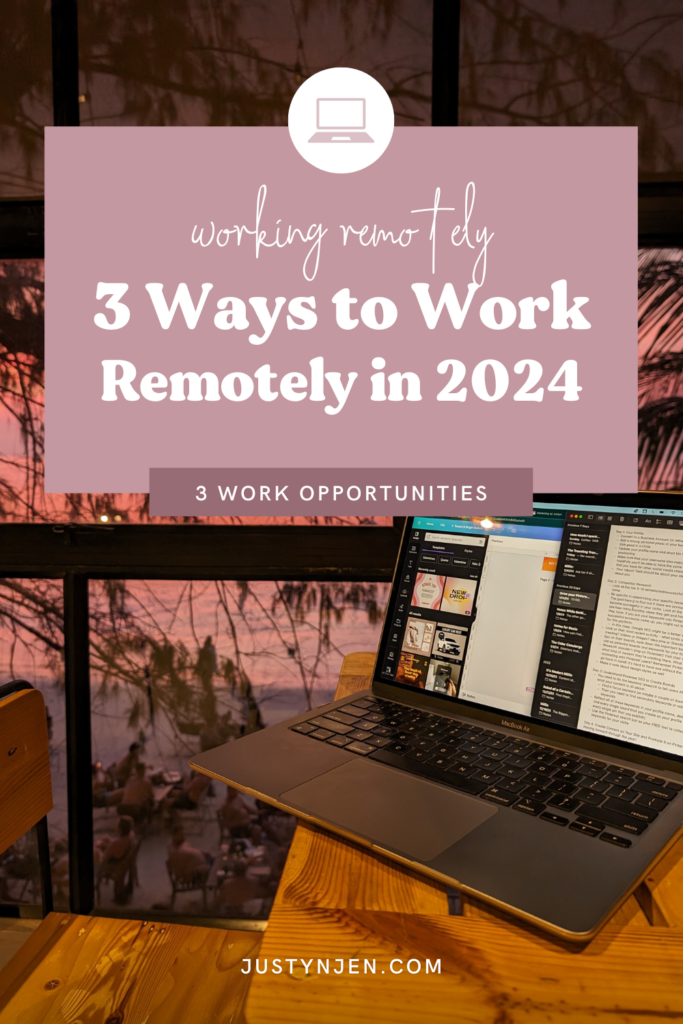Do you want to work remotely in 2024? Today I will be sharing 3 ways that you can start working remotely and use that freedom to travel the world this year!
The top questions that I always get online are about what I do for a living and how I travel as much as I do. If you’re new around here – I’ve been traveling full-time since 2015. During that time I’ve been to over 50 countries, lived in a van exploring 25 states, and spent prolonged periods in Bali, London, and Slovenia.
So how do I do it?
I’m a nursing school dropout who learned how to work online when the alternative meant going home (i.e. back to my parent’s basement) to work and save money for more travel. My first online work was as a virtual assistant but I’ve done all forms of marketing, worked on UpWork, and managed to land a few brand deals and travel opportunities.
Today I’m going to dive into 3 specific ways that you can work remotely. I’ll be sharing the pros and cons of each style of remote work and link you to some additional resources to get started.


3 Ways to Work Remotely in 2024
1. Find a Traditional 9-5 Remote Position
The first option to work remotely in 2024 is to find a traditional 9-5 job that allows you to work remotely. Or negotiate with your current position to go remote – or at least remote part-time. Remote part-time could mean that you work for 2-3 months as a time remotely and are able to spend that time traveling.
Post-Covid it’s so much easier to negotiate a remote position – and I’ve even read that European companies are scooping up American workers who want to work remotely, but whose current job doesn’t allow it.
The Pros of a Remote 9-5
- Job security
- Stable (typically higher) income
- Typical benefits that come with a full-time job (like vacation time, sick leave, and health insurance)
- Being a part of a team
The Cons of a Remote 9-5
- Your travels can be limited by timezones (i.e. if you’re working for a company based in the US, you could work and travel in Central America or Europe, but Asia would make being online during business hours more difficult)
- Being disciplined to get your work done when you want to be exploring
- Feeling disconnected from your team
Traveling full-time with a traditional 9-5 that allows you to work remotely, means you’re going to need to travel very slowly. Take my friend Jess for example; she and her partner have spent over 6 months exploring Europe with full-time jobs back in the US. Each month they move to a new city, stay in an Airbnb they’ve rented, and spend the weekends exploring.
If your work won’t allow you to work remotely, consider negotiating to be part-time remote. I met a girl in Thailand from Amsterdam and her job allows her to work remotely for 4 months out of the year.



2. Work Remotely as a Virtual Assistant
This is one of my favorite ways to recommend people work remotely in 2024 because VA work is readily available! Businesses around the world need VAs for tasks from marketing to time and team management.
In fact, I’ve shared a huge guide with over 110+ services you can offer as a virtual assistant. Make sure to check that out here.
The Pros of Working Remotely as a Virtual Assistant
- You can usually work fewer hours/fewer days a week which means more time to explore and adventure
- More freedom with time and location. Depending on the work that you’re doing, you might not have to be online for the whole business day. This can allow you to travel farther and wider.
- Overall greater flexibility
- You choose your clients → which means you can choose to work with people who allow you to continue your lifestyle!
The Cons of Working Remotely as a Virtual Assistant
- You need to be self-motivated. It’s important that you get your work done and maintain a high standard in order to keep your clients happy
- Work can come and go, if you lose a client you might not know when you’ll be able to replace them
- Sometimes you’ll find yourself taking meets at 02:00 am depending on where in the world you are (this isn’t a bad trade-off for location independence though!)
- You won’t have the benefits of a typical remote position → no PTO, health insurance, etc.

3. Work Remotely for Yourself
Next up you could work for yourself by taking on clients for marketing, web design/development, social media, etc. This is the category I would put myself under. It’s different from being a Virtual Assistant because you typically don’t have to worry about when the business owner is online.
For example, my partner works as a web designer and developer for clients in the UK and Europe. He can be anywhere in the world because his only obligation is to deliver their website on time. There will be the occasional meeting he needs to be online for, but most of his work is done independently of his client’s schedule.
My work is very similar to that!
The Pros of Working Remotely for Yourself
- Absolute time freedom → I make my own schedule, can take days off in the middle of the week, and don’t have to report my time to anyone.
- Ability to work with clients in the US and live in a country where my money goes further. This means I can keep my cost of living low without having to worry too much about how many clients I have.
- I can fly to Thailand on a Wednesday without telling a soul.
The Cons of Working Remotely for Yourself
- Absolutely no job security. Both I and my partner have had really good months and really bad months
- You have to market yourself and constantly work on your own business along with your clients
- You’re not part of a team, so work can get lonely
- Planning for the future and retirement falls solely on you. It’s important to have money saved in an emergency fund (for the slow months) and be saving for your retirement.
At the end of the day, working remotely for myself is the best move I’ve ever made. I love the ability to do all of my work without ever ‘clocking in’ or reporting to anyone. I live for that “fly to Thailand on a Wednesday without telling anyone” energy.
In my opinion, these are the top 3 categories or avenues that you can go down to work remotely and travel more in 2024.
If I was starting over, I’d start by looking for a remote role at a traditional 9-5, that would allow me to travel slowly throughout Europe or Central and South America. After doing that for a couple of years, I would transition to online work as a Virtual Assistant for more flexibility and freedom.
After working a remote 9-5 and as a Virtual Assistant, I would then determine if I wanted to go down the root of working solely for myself based on the lifestyle I’m looking to maintain and the work that I want to do.


Traveling More in 2024
Other ways that you can travel more in 2024 without adjusting your work would be things like maximizing your PTO and vacation time (or negotiating for more!). As Americans, we’re not given nearly enough PTO → I recommend negotiating that!
And requesting a sabbatical from work. This is another perk I’ve realized that many Europeans have. They’ll negotiate with their current employer to have 3-4 months off work, then they’ll spend that time traveling. I have met multiple people traveling in South East Asia on sabbatical from their work.
Lastly, if your main goal is to travel more in 2024, you can work seasonal jobs that give you part of the year off automatically. I used to work at a ski resort during the winter and travel in the summers. You can also look into seasonal work abroad and visas that allow you to travel and work in countries like Australia and New Zealand!
What questions do you have about working remotely in 2024? Or traveling more in 2024! Let me know below.
As always, you can follow the adventure on Instagram and TikTok @justynjen.
If you loved this post and want to show some support for my site, consider donating a cup of coffee through my Ko-Fi page. Thank you!
Save this post to Pinterest!






